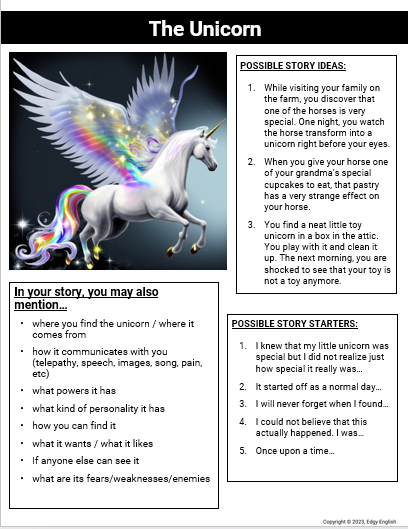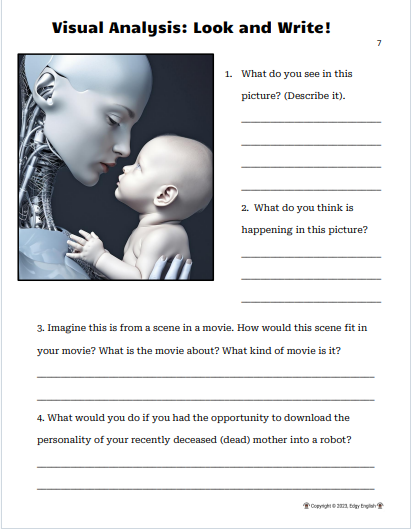20 Best Ways to Use Picture & Writing Prompts
Picture prompts can serve many functions in a classroom, especially in an ESL setting. From eliciting language production to fostering critical thinking, the use of images can enhance a student's engagement, understanding, and retention of the language. Here are 20 functions that picture prompts can serve for the learner:
Vocabulary Building
Creating Stories
Describing Objects/Situations
Practicing Prepositions
Understanding Cultural Contexts
Grammar Practice
Role-Playing
Promoting Class Discussion
Improving Writing Skills
Enhancing Listening Skills
Expressing Opinions and Feelings
Comparing and Contrasting
Making Predictions
Sequencing Events
Problem-Solving
Teaching Idioms and Proverbs
Understanding Non-Verbal Communication
Practicing Question Formulation
Evaluating and Prioritizing
Creating Personal Connections
1. Vocabulary Building:
Pictures can serve as an excellent tool for vocabulary building. For instance, a teacher might present a picture of a farm and ask students to identify the objects or animals they see. This exercise can introduce new words like "barn," "tractor," or "haystack," while reinforcing familiar terms. For ESL students, visual representations can aid memory and make the learning process more engaging.
2. Creating Stories:
One of the most exciting ways to use picture prompts is to encourage students to create their own stories. Given an image – for example, a picture of a deserted road – students can use their imagination to create a narrative around it. This encourages creative thinking and allows students to apply the vocabulary and grammar structures they've learned in a fun, imaginative way.
3. Describing Objects/Situations:
Description is a key communication skill, and picture prompts can provide plenty of practice. A picture of a busy city street, for instance, can lead students to describe buildings, people, vehicles, and weather conditions. It also gives students the opportunity to practice using adjectives and adverbs to add detail to their descriptions.
4. Practicing Prepositions:
Picture prompts can be used to practice prepositions of place. An image of a room with various objects can enable students to form sentences like "the lamp is on the table," or "the cat is under the chair." This hands-on application helps solidify understanding of prepositions.
5. Understanding Cultural Contexts:
Pictures from different cultures can be used to teach students about traditions, norms, and lifestyles worldwide. For example, a picture of a Japanese tea ceremony can introduce students to the culture and etiquette of Japan. Understanding cultural contexts is crucial in language learning, as language and culture are intertwined.
6. Grammar Practice:
Teachers can use picture prompts to practice specific grammar points. A series of pictures can be used to teach verb tenses by asking students to narrate the story in the past, present, or future tense. Similarly, a picture depicting several actions simultaneously can be used to practice the present continuous tense.
7. Role-Playing:
Picture prompts can serve as a basis for role-play exercises. An image depicting a restaurant scene, for instance, can lead to a role-play activity where some students are customers and others are waitstaff. Role-playing can help students practice real-world conversations and improve their confidence in using the language.
8. Promoting Class Discussion:
Picture prompts can lead to interesting class discussions. A thought-provoking image – say, an environmental issue like deforestation – can stimulate conversation, allowing students to voice their opinions, agree or disagree, and learn to articulate their thoughts in English.
9. Improving Writing Skills:
Pictures can be used to inspire writing tasks. A beautiful landscape image, for instance, can serve as a prompt for a descriptive writing exercise. Similarly, an image depicting a social issue can be used for an opinion essay.
10. Enhancing Listening Skills:
Teachers can describe a picture and have students draw it based on what they hear. This activity can enhance listening comprehension and ensure students can understand and act upon spoken instructions.
11. Expressing Opinions and Feelings:
Pictures can encourage students to express their feelings and opinions. An image that evokes strong emotions – like a picture of a war zone or a joyful carnival – can lead students to express their reactions, providing an excellent opportunity to learn emotion-related vocabulary.
12. Comparing and Contrasting:
Two different pictures can be used to practice comparing and contrasting. For example, images of a rural and an urban setting can be used to contrast lifestyles, landscapes, and activities. This helps students practice comparative structures and enhances their critical thinking.
13. Making Predictions:
Making predictions based on a picture is another useful activity. Given an image – for instance, someone standing on the edge of a diving board – students can predict what will happen next. This helps students learn to use modal verbs of probability.
14. Sequencing Events:
A series of pictures can be used to practice sequencing events and telling stories. This can be especially useful when practicing narrative tenses or when teaching words and phrases related to sequence (like "first," "then," "after that," etc.).
15. Problem Solving:
Pictures can also be used to create problem-solving exercises. For example, a picture might depict a complicated traffic situation, and students can be asked to suggest solutions. This encourages critical thinking and the use of imperative forms.
16. Teaching Idioms and Proverbs:
Visual prompts can help students understand idiomatic expressions and proverbs. For example, a picture of a cat among pigeons can be a starting point to discuss the idiom "like a cat among the pigeons," making these often confusing elements of language more memorable.
17. Understanding Non-Verbal Communication:
Picture prompts can also help teach non-verbal communication. Pictures of people exhibiting various emotions and body language can help students understand and interpret non-verbal cues, which are crucial for effective communication.
18. Practicing Question Formulation:
Teachers can use pictures to help students practice formulating questions. Given a picture, students can formulate questions related to it, such as "Who is the woman in the picture?" or "What is the man doing?"
19. Evaluating and Prioritizing:
Pictures can be used to practice evaluating and prioritizing. For example, an image of a messy room can lead to a task where students have to prioritize cleaning tasks and justify their choices.
20. Creating Personal Connections:
Finally, pictures can be used to create personal connections. A picture can serve as a prompt for students to talk or write about similar experiences or feelings, helping them express themselves in English.
By serving these functions, picture prompts not only aid in developing language skills but also foster critical thinking, creativity, cultural awareness, and personal expression. Their versatility makes them an invaluable tool in any ESL classroom, especially in a world where visuals play such a significant role in communication. The usage of picture prompts can be likened to the use of visuals in video games, social media, and other digital platforms. By integrating a similar method in the classroom, educators can provide a learning experience that resonates with students' digital habits, thereby facilitating a more effective and engaging learning environment.













